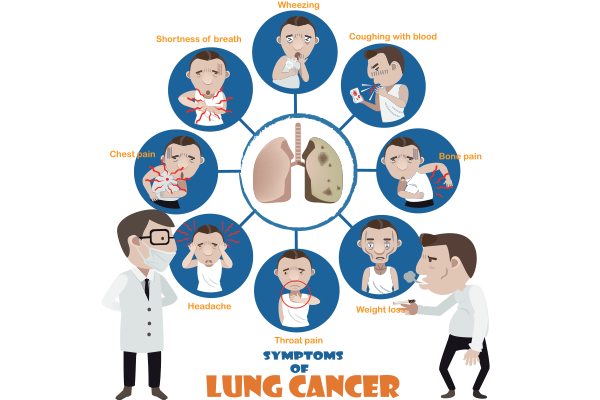
Lung tumours, whether benign or malignant (lung cancer), can be life-threatening if not detected early. Unfortunately, the early stages often present with subtle or seemingly harmless symptoms, making early diagnosis a challenge. Understanding the warning signs can lead to prompt medical attention and significantly better outcomes. In this blog, we have discussed all the aspects of it in great detail. We have also included some tips shared by our experienced pulmonologist in Gurgaon to boost lung health and prevent lung disorders.
10 common Lung Tumour symptoms
1. Persistent Cough
A lingering cough that lasts more than two or three weeks, especially if it worsens over time, is one of the most frequent early symptoms of a lung tumour. It may start as a dry cough and evolve into one producing phlegm or blood. It happens when tumours irritate the airways or block bronchial tubes, which triggers the cough reflex.
2. Coughing Up Blood (Hemoptysis)
Even a small amount of blood in the sputum should never be ignored. This symptom may indicate bleeding from a tumour inside the lung. However, infections like tuberculosis can also cause hemoptysis, which is a red flag that warrants immediate medical attention.
3. Shortness of Breath
Breathlessness can occur due to obstruction of airways by the tumour, fluid around the lungs (pleural effusion), or decreased lung capacity. Patients often report difficulty catching their breath after climbing stairs or engaging in light physical activity. This is normal in many cases, but if you feel anything amiss or abnormal, you must consult our best pulmonologist in Gurugram for consultation.
4. Chest Pain
Chest pain may be sharp or dull and might worsen with deep breathing, coughing, or laughing. It may be localised or radiate to the shoulder or back. The tumour pressing against nerves or invading the chest wall can lead to persistent discomfort.

5. Unexplained Weight Loss
Sudden weight loss without trying is a common symptom of many cancers, including lung cancer. This is due to the body’s increased energy expenditure and tumour-induced metabolic changes. A drop of 10 pounds or more in a short time with no change in diet or activity level is concerning and must be reported.
6. Fatigue
Cancer-related fatigue is more intense and persistent than normal tiredness. It doesn't improve with rest and can severely impact daily functioning. The tumour may release substances that alter body metabolism and energy balance.
7. Hoarseness
A change in voice, especially if it becomes raspy or hoarse, could be due to tumour involvement of the recurrent laryngeal nerve (which controls the voice box). If hoarseness persists beyond two weeks, it should be evaluated.
8. Frequent Respiratory Infections
Lung tumours can block airways, creating areas where bacteria can thrive, leading to repeated infections such as bronchitis or pneumonia. If you're being treated for a chest infection that doesn’t fully clear or keeps coming back, further investigation is needed.
9. Swelling in the Neck or Face
A tumour in the upper part of the lung (known as a Pancoast tumour) may compress major veins like the superior vena cava, causing facial or neck swelling, often accompanied by visible veins on the chest.
10. Bone Pain
Advanced lung cancer may spread (metastasise) to bones, especially in the spine, hips, or ribs, causing persistent or worsening bone pain.
Many of these symptoms can be caused by other conditions like infections or Chronic Obstructive Pulmonary Disease (COPD), but it’s the persistence and combination that are concerning. If you or a loved one experiences several of these symptoms for more than a couple of weeks, don’t delay seeking medical evaluation.
Tips to Promote Lung Health
Eat Lung-Friendly Indian Foods
-
Turmeric (Haldi): Contains curcumin, a powerful anti-inflammatory. Drink turmeric milk or add to curries.
-
Tulsi (Holy Basil): Known to reduce respiratory inflammation. Consume as tea or chew fresh leaves.
-
Ginger & Garlic: Help reduce mucus and clear nasal passages.
-
Amla (Indian Gooseberry): High in Vitamin C, boosts immunity and lung repair.
-
Leafy Greens: Spinach (palak), fenugreek (methi), and mustard greens (sarson) are rich in iron and antioxidants.
-
Citrus Fruits: Oranges, mosambi, lemon—support collagen and immunity for the lung lining.
-
Millets (Bajra, Jowar, Ragi): Rich in magnesium and fibre, they support overall respiratory function.
-
Nuts & Seeds: Almonds, walnuts, and flaxseeds provide omega-3s, which combat inflammation.
Stay Physically Active
-
Aim for 30 minutes of brisk walking or cycling daily.
-
Regular exercise helps improve lung capacity and oxygen utilisation.
-
In metro cities, prefer indoor workouts when the AQI is poor.
Say NO to Smoking & Passive Smoke
-
Tobacco is the leading cause of lung cancer and Chronic Obstructive Pulmonary Disease (COPD).
-
Even passive smoking at home or in public spaces is harmful.
-
Consider herbal alternatives or nicotine replacement therapies for quitting.
Conclusion
Early detection of lung tumours significantly increases the chances of effective treatment. Unfortunately, because early symptoms are often mild or attributed to other causes, many people ignore them. By being aware of the signs and acting promptly, you can take a crucial step toward protecting your health.
FAQ's
A lung tumour is an abnormal growth of cells in the lungs. It can be:
-
Benign (non-cancerous): Rare, doesn’t spread, and usually grows slowly.
-
Malignant (cancerous): Grows aggressively and can spread (metastasise) to other parts of the body.
-
Most concerns about lung tumours relate to lung cancer, which can be either non-small cell lung cancer (NSCLC) or small cell lung cancer (SCLC).
Early symptoms may be subtle or mistaken for other illnesses. Common signs include:
-
Persistent cough
-
Shortness of breath
-
Chest pain
-
Coughing up blood
-
Unexplained weight loss
If these symptoms last more than a few weeks, medical evaluation is essential.
The most common risk factors include:
-
Smoking (accounts for ~85% of lung cancer cases)
-
Exposure to secondhand smoke
-
Air pollution (especially in urban areas)
-
Family history of lung cancer
However, even non-smokers can develop lung tumours due to genetic factors or environmental exposures.
Diagnosis typically involves:
-
Chest X-ray or CT scan to detect abnormal masses
-
PET scan to assess the activity of the tumour
-
Bronchoscopy or needle biopsy to collect tissue samples
-
MRI or bone scans if metastasis is suspected
Early-stage detection often improves treatment outcomes significantly.
Treatment depends on the type, stage, and patient’s overall health. Options include:
-
Surgery – for localised tumours
-
Radiation therapy
-
Chemotherapy
-
Targeted therapy for tumours with specific genetic mutations
-
Immunotherapy – to help the immune system attack cancer cells
A multidisciplinary approach is often used for the best results.





















 6 Min Read
6 Min Read















